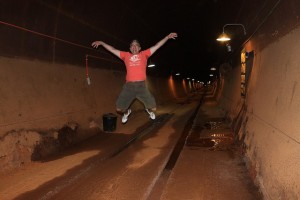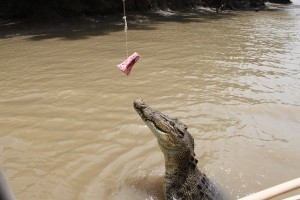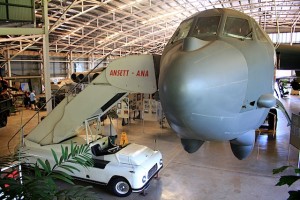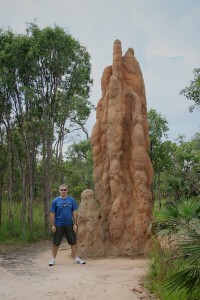Traveling around Australia has, if nothing else, demonstrated what a resilient lot Australians are. However, a few days in Darwin takes this understanding to a whole new level. Withstanding the hot, humid weather is perhaps a given for any Australian, but add to this devastating cyclones and World War II bombing, all of which literally flattened the city, and the residents of Darwin may be considered some of the most resilient.
Darwin was last flattened on Christmas Eve 1974 when Cyclone Tracy ravaged the city. It is this event that has resulted in Darwin looking like a new town as you wander the streets today as indeed, the majority of the town has been constructed since this time. A few pre 1974 buildings survive to offer a reminder of the towns history, like the ruins of the town hall. Like the Cyclone distributing Darwin with it’s 200 mph winds across the peninsular, the remains of the Town Hall are also spread with doors and windows being located in Museum and Art Gallery of the Northern Territory – some miles from the original location – but an interesting way to spend half a day. In addition to an excellent Cyclone Tracy display, wildlife and Aboriginal art are strongly represented.
Prior to the 1974 disaster, the town was devastated by bombing by the Japanese on 19 February 1942. These were the largest attacks ever mounted by a foreign power against Australia and further attacks continued into the war. Whilst European women and children settlers were evacuated from the town during hostilities, the aboriginal community remained intact.
Following the attacks plans were drawn up for the construction of seven underground oil storage tanks. Of the seven, five were actually constructed with the final two delayed because of lack of materials and difficulty in waterproofing the tunnels. Today, a short walk from the town centre will take you to the entrance where you can peer inside one tank, and walk the full length of another viewing photographs of Darwin during the war years as you go.
Visiting the Oil Tunnels put me in the mood to find out more of Darwin’s past and a short drive along the coast makes easy work of bringing history to life. Darwin’s East Point Reserve was a heavily fortified area and important part of Darwin’s defences and now a highlight for any visitor to Darwin with any war time interest. I particularly enjoyed exploring a massive gun bunker that was apparently installed to defend Darwin Harbour from an assault from the sea, an event which fortunately never eventuated. Rather ironically, the massive gun from the bunker was sold to the Japanese after the war as scrap metal.
It appears that the flattening of Darwin is almost a once in a generation occurrence. Severe cyclones have been recorded in 1878, 1881 and the ‘Great Hurricane’ of 6 January 1897 which was recorded as “a night of terrifying destructiveness” as it coincided with a high tide. Not to forget to mention the wiping out one quarter of the population of the infant Darwin in 1875 because they were all travelling on the same boat, the Gothenburg, in … a cyclone.
If the weather does not get you mother nature still has a few more tricks up her sleeve. Take the crocodiles that inhabit the waterways surrounding this town and others in the Northern Territory. I was fortunate to have a boat trip up the Adelaide River where crocodiles were in no shortage and were more than happy to jump out the water for a chunk of pork as a reward. I was literally sat on the edge of my seat and keeping all my limbs within the boat at all times was a given for me and all the other passengers.
The Aviation Heritage Centre operated by the Historical Society of the Northern Territory was established in 1976 by a small group of enthusiasts who sought to preserve aviation relics salvaged after the destruction of Cyclone Tracy. With a Boeing B-52 bomber taking centre stage, this well presented collection of aviation memorabilia is worth adding to any itinerary.
With botanical gardens and world class Litchfield National Park on the door step, nature lovers have much to keep them interested. I found both to be great spot to relax and unwind prior to the trip back home. Kakadu is also nearby but a little too far to do justice on a short four day trip.
Four days in Darwin was about right with sufficient attractions to keep interest without having to travel too far outside the township. Those with longer time on their hand may look to travel further afield to Kakadu, Katherine, Tennant Creek and Alice Springs which are all comparatively close by – well by Australian standards at least.
Further Darwin photos are located here.







Did you visit the Jail at Fanny Bay?
Tell her I’m droving down Camooweal way Or signed with pearlers for seas far away You can tell her I’ve gone, I’ll be back some day Please don’t tell her they hanged me in old Fannie Bay.
You can say I’ve gone on the old ‘River Queen’ It’s whistle a-haunting the bullockies’ dream, Down the Murray I’ve gone, I’ll be back some day Please don’t tell her they hanged me in old Fannie Bay.
Chorus: And on Thursday Island the sun wams the air As the breeze from the sea blows her hair And she sits by her window and calls me Yes, she calls me.
You can say the bush has called me away And I’m riding the fences for ten bob a day, Yes, I needed a job, I needed the pay Please don’t tell her they hanged me in old Fannie Bay
Chorus: And they came to the door and they dragged me away From all that I love and I pray That it won’t reach her ear ’cause I love her And she’d die for sure
Just say the gold has taken me down To the places where fortunes are easily found Yes, I’ve gone but tell her I’ll be back some day Just don’t tell her they hanged me in old Fannie Bay